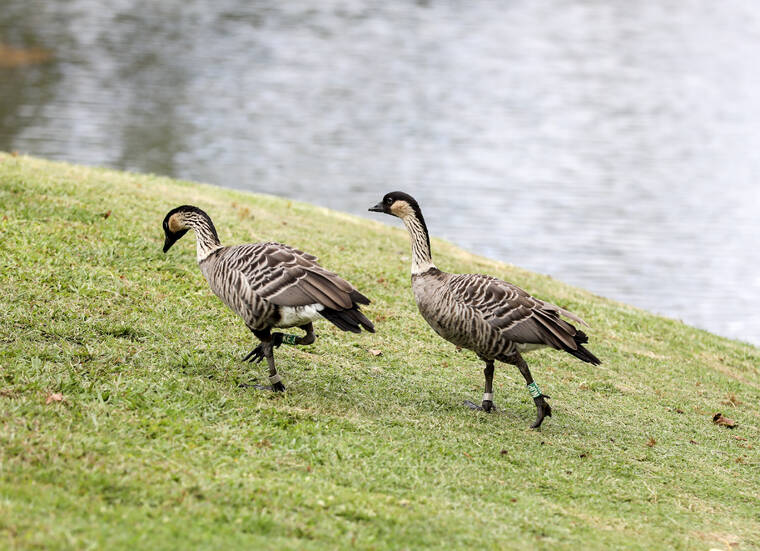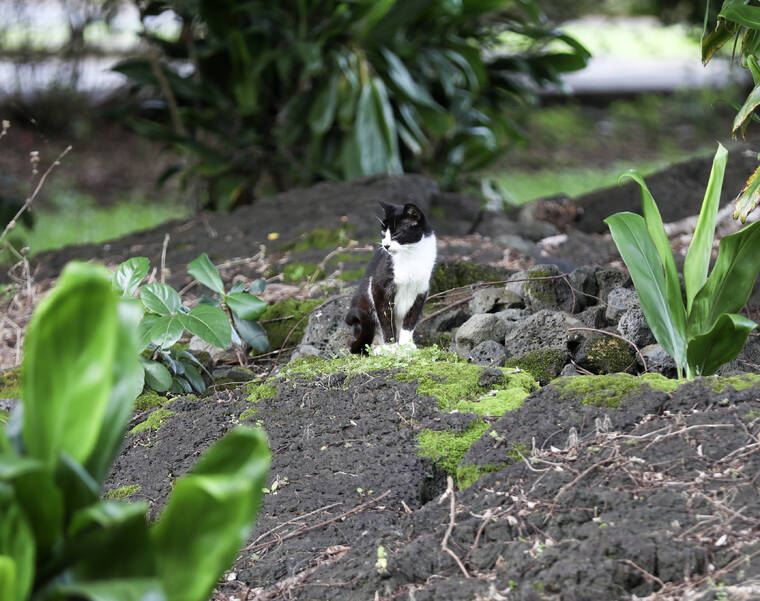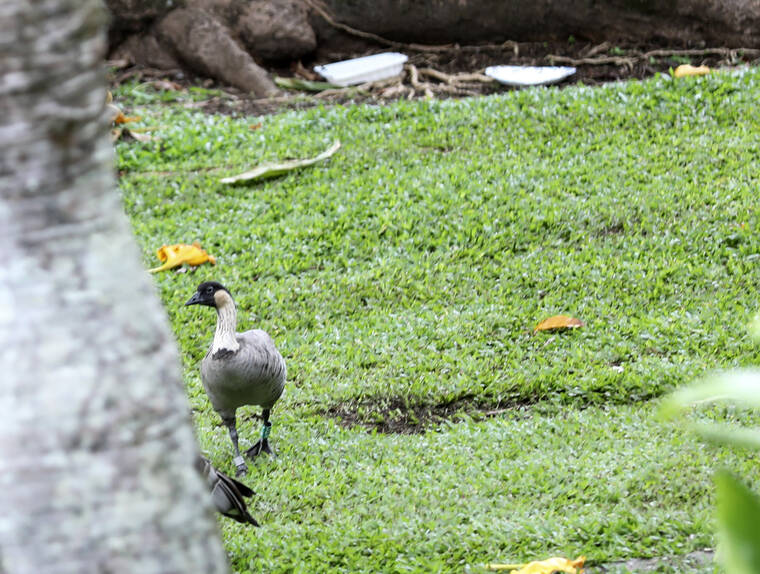State and county agencies are moving forward to address feral cat feeding and its effects on the nene population.
Last week, the Department of Land and Natural Resources released a the results of a necropsy performed by the U.S. Geological Survey National Wildlife Health Center on a one-month old nene who died at Lili‘uokalani Park and Gardens in March.
The post-mortem test implicated the disease toxoplasmosis, which comes from a parasite spread in cat feces, as the cause of death of the gosling.
The park is home to a long-standing colony of at least 70 cats, which are fed regularly by individuals.
Despite the nene’s death, community members have continued to feed feral cats along Banyan Drive in Hilo with cameras catching nene eating the cat food alongside the felines.
Raymond McGuire, a wildlife biologist with the DLNR Division of Forestry and Wildlife, DOFAW, has taken it upon himself to remove paper plates full of cat food and dump them in the trash several days a week, several times a day.
“It’s frustrating because I know the community loves the nene here. I got so many phone calls from people who were elated that a nene hatched in the park,” McGuire said. “For a month, (the nene family) looked happy, and people were happy because they got to see wildlife in their backyards.”
Officers with DLNR Division of Conservation and Resources Enforcement, or DOCARE, have stepped up patrol in Lili‘uokalani Park and cited Doreen Torres, 66, after spotting her feeding feral cats on Wednesday.
She was issued two citations for violating state endangered and threatened species laws, which prohibit the feeding of protected wildlife, since nene may eat the cat food.
McGuire says there’s a disconnect between feral cat feeders, who love animals, and their actions, which harm and kill wild animals like nene.
“(It’s) not just nene, but monk seals. And not just toxoplasmosis, but cats attack and eat native birds,” McGuire said. “We want people to understand there’s a place for these cats. Keep them home. Never abandon a cat.”
When the nene gosling was growing in February, Hawaii County Parks and Recreation director Maurice Messina visited the park with McGuire and noted seeing the plates of food for cats being left in the park.
“We are aware of the necropsy released by DLNR that the nene gosling died of toxoplasmosis,” Messina said. “To us, it is very serious that the feral cat population at our park may have caused the death of the nene gosling.”
According to Messina, Parks and Rec has been working with the county administration and with components of DLNR to devise a plan to address the issue of feral cat colony management that affects native species.
“We’re taking the matter seriously and will continue to work with DLNR and the administration to figure out how to move forward with this delicate situation,” Messina said.
Jordan Lerma from Nene Research and Conservation said that advocates with the nonprofit are trying to shift the conversation and bring both animal-loving sides together to find solutions.
“Nene are an easy species to connect the community to conservation. I think the cat community are animal lovers and I think they mean well,” Lerma said. “We just need to be able to work together to solve these hard problems that prioritize native species.”
After DLNR banned feral cat feeding at Queen’s Marketplace in Waikoloa last year, the nonprofit tried to facilitate discussions with cat advocates and DOCARE, but encounters got heated and emotional.
Lerma hopes that any future conversations regarding the issue can remain productive and more empathetic to each side.
“I think a lot of these people are putting their life savings on the line to care for these animals that they love. I want to acknowledge and respect that,” Lerma said. “We want to facilitate these conversations with county, state, and federal officials in order to give these people the resources they need to be able to remove, eliminate, or reduce cat interactions with native species.”
Nene Research and Conservation recently introduced a cat mapping tool to get a better idea of the extent of feral cat populations. They have estimated that 500,000 to 1,000,000 feral cats live on Hawaii Island.
For more information on public wildlife resources in Hawaii, visit dlnr.hawaii.gov/wildlife/
Email Kelsey Walling at kwalling@hawaiitribune-herald.com










